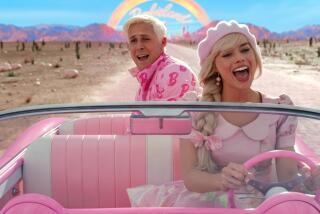Black and white lights up screens in ‘Frances Ha,’ ‘Nebraska’
When Hollywood began transitioning from black-and-white films in the early 1960s, the director Vincente Minnelli had a simple, dismissive reply to those who questioned the shift. “Color,” he said, “can do anything that black-and-white can.”
A half-century later, a significant group of filmmakers begs to differ.
Don’t look now, but the black-and-white movie is making a comeback. Long after the form fell out of vogue — and in an era when many big-budget studio films pack the screen with saturated candy colors and in-your-face 3-D effects — indie filmmakers and even the occasional studio-movie veteran are turning to the monochromatic.
PHOTOS: Behind-the-scenes Classic Hollywood
One of the biggest art-house hits of the year, Noah Baumbach’s “Frances Ha,” was shot in black and white, following 2012 best picture Oscar winner “The Artist.” The director who boasts the highest-grossing film of 2012, “The Avengers’” Joss Whedon, shot his most recent movie, a personal adaptation of Shakespeare’s “Much Ado About Nothing” that he filmed in his own home, in the same muted color scheme.
And one of the most anticipated movies of the fall — Alexander Payne’s father-son drama “Nebraska,” received a rapturous reception at the Cannes Film Festival in May — is equally devoid of almost anything that can be found in a Crayola box.
Throw in the black-and-white 3-D opening sequence of “Oz the Great and Powerful” and the entirety of Randy Moore’s Disneyland-set 2013 Sundance Film Festival sensation “Escape From Tomorrow,” and it adds up to a black-and-white bumper crop.
“There’s something about making a black-and-white movie in this moment of huge superhero films that says we’re still doing it; we’re still making movies,” said Greta Gerwig, who starred in and co-wrote “Frances Ha.” “It feels like an act of rebellion.”
Few, of course, are predicting black-and-white movies will become the dominant coin even for art-house pictures. But there’s little doubt it’s on the rise, offering the cinematic corollary to the vinyl record and ushering in a moment for — and a set of commercial and artistic questions about — a long-forgotten form.
PHOTOS: Hollywood backlot moments
Already a small brotherhood is forming around the style. When Baumbach unveiled “Frances Ha” at the Telluride Film Festival last year, he was quickly approached by Payne, who was preparing to shoot “Nebraska” and wanted some tips. The two spent hours discussing it.
For many of us, black-and-white films offer a nostalgia factor. Almost no one younger than 60 came of age seeing them in a theater, and even black-and-white television sets are a curiosity to many under 40. “The black-and-white movie in the 21st century is something that’s old enough and far enough in the past that it can start to feel like the avant-garde again,” said Robert Thompson, a pop-culture professor at Syracuse University.
But the filmmakers say that their motivations go beyond simply ginning up some throwback charm. For Whedon, setting a 16th century play in the modern day meant a complex balancing act; he needed a technical trick to ensure it all still felt like the Bard. “I wanted to get the elegance without the formality,” he said.
“Oz” producer Joe Roth said he sought to have his film’s opening feel as different as possible from every other big-budget movie at the multiplex. This way, when the film segues to its modern vibrant section, viewers would really notice the difference.
“Frances Ha,” about a twentysomething lost soul, had its own creative reasons: It was trying to capture the fleeting nature of youth. “Black and white creates an instant nostalgia, which is right for the story, which is about moments passing that you’re not even aware are passing until after they’re gone,” said Gerwig, who noted that the style also helped her performance. “It adds an element of unreality that allowed me to feel I could be as big as I wanted to be and it wouldn’t read as false.”
In “Nebraska,” the black and white lends Payne’s film — which is about an older character returning to his childhood hometown — a similar trip-down-memory-lane feel. The monochrome also neatly reflects the desolation and economic blight of the movie’s small-town setting, much like classics “The Last Picture Show” or “The Grapes of Wrath.”
“It fit both thematically and with the story,” said Payne, adding that nearly every day on set he wondered how he’d go back to color. “Black and white is king,” he said.
Moore saw black and white as a tool to make a political point in his film, which is a horror movie of sorts set at the country’s well-known amusement parks. “Disneyland wants to present itself as such a colorful place, and I wanted to show that the cheer could make people feel very lonely and drab,” he said.
Certainly a black-and-white film offers a different viewing experience. For certain genres, like mysteries, black and white can create a harder-edged vibe. The French New Wave employed it to create a sense of brooding atmosphere. And in film noir the interplay of shadows and light is helped immeasurably by black-and-white.
Others maintain it allows the viewer to engage differently no matter the genre.
“When there is no color in the discussion, your eye isn’t managing as much information, and that changes the experience,” said “Frances Ha” cinematographer Sam Levy. He also said black and white rendered production easier — the “exquisite simplicity,” as he called it, allowed him to shoot in locations that wouldn’t work if the camera was able to pick up clashing colors. (Black and white doesn’t require any special technology or added costs, though given the radically different look it creates, some cinematographers are less comfortable working with the form.) Because most movies are now shot digitally, modern black and white does have a different look that it did in the 20th century, offering sharper and more vivid contrasts.)
REVIEW: ‘Frances Ha’ a charming portrait of youth and spirit
The new vogue for black and white is a reversal of the colorization movement of the 1980s. Back then a small group of companies, often over a public outcry, added color to vintage black-and-white movies. Now a different group is doing the reverse, draining color from modern movies.
They may face their own obstacles. The mainstream moviegoing crowd — and thus, by extension, studios — is thought to be resistant to black-and-white movies. Payne said to convince Paramount to make “Nebraska” he had to agree to a comparatively low budget. (The studio has prepared a color version for foreign TV stations whose deals exclude black and white.)
But the director said he thinks concerns about theatrical audiences are unfounded. “Did fewer people see ‘Manhattan’ or ‘Schindler’s List’ because they were in black and white?” he asked. “The idea seems driven more by fear than empirical evidence.”
Still, like any revival act — think modern bands retro-ed out in suspenders, bowler hats and accordions — black-and-white movies can come off as self-conscious. Thompson says that whenever he sees a trailer in those colors it evokes in him a suspicion of pretension — “it’s trying to say Art with a capital A” — that the movie then has to overcome.
Meanwhile, for all the warm feelings many older black-and-white movies generate, it’s not clear that they’re by definition more appealing. Are “Casablanca” and “Citizen Kane” made inherently better by the fact that they’re in black and white? Or do they just seem that way because that’s how we’re used to seeing them?
Besides, making a movie in a form that doesn’t represent how most of us see the world is not so much an exercise in stripped-down realism as it is its own brand of stylization. The notion of black and white, it turns out, is hardly that.
More to Read
Only good movies
Get the Indie Focus newsletter, Mark Olsen's weekly guide to the world of cinema.
You may occasionally receive promotional content from the Los Angeles Times.







